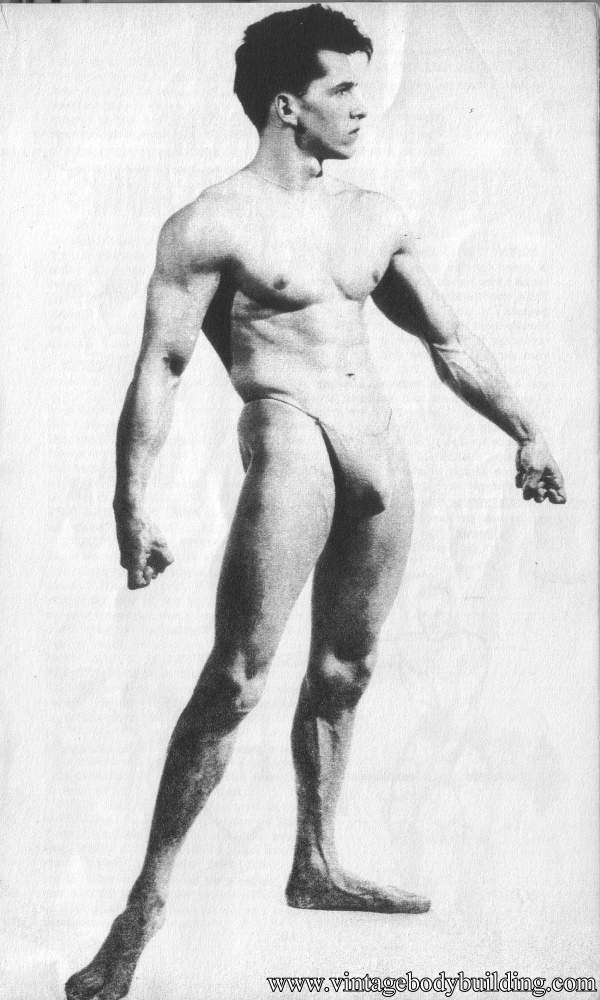
Physique photo blog
Two vintage bodybuilder posing
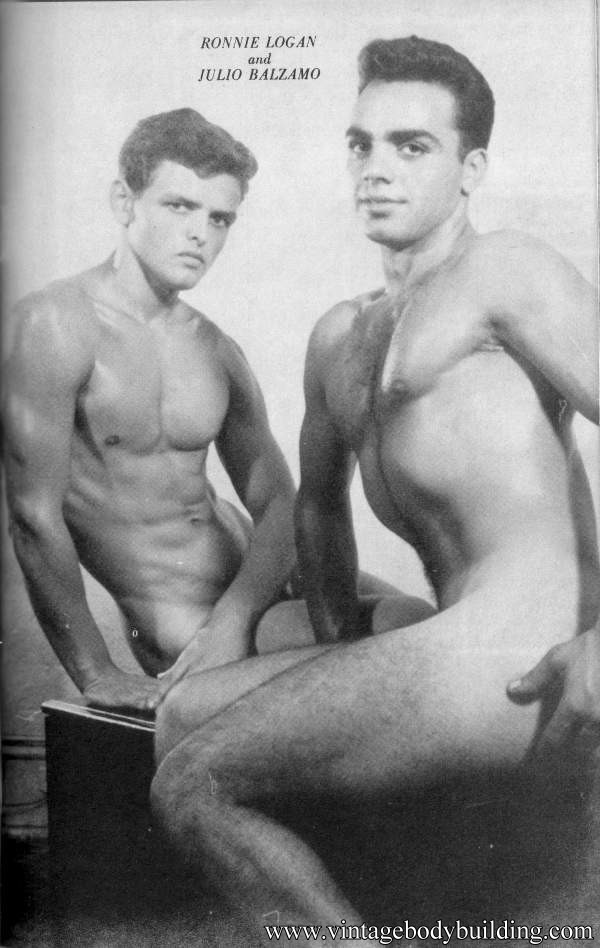
Practical Psychology
by Peter Carrick
YOU know, the people who bound through life in a natural, confident manner, those self-possessed, positive-thinking individuals, never fully realise how lucky they really are. In any endeavour, and especially in bodybuilding, they start out with a tremendous advantage over their more negative-minded friends. That doesn’t mean, however, that a retiring, negative individual should be content to sit back and use his inferiority as an excuse for his lack of progress.
If you happen to be one of those unfortunate people who, like myself, are naturally prone to worry and a negative attitude towards life, then you must learn what to do so that your way of life will be improved.
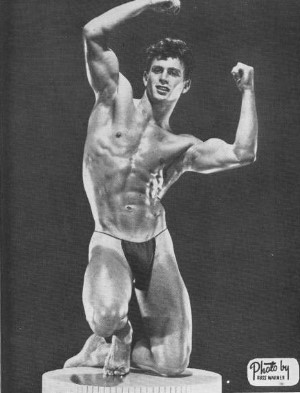
Practical psychology is, without doubt, your saviour.
In my last article I told you that practical psychology, when properly applied, could help the negative-minded bodybuilder to derive more benefit from his training. This month I intend to explain how certain principles of practical psychology can best be applied by the body-builder for his own benefit.
Firstly, the essential ingredients for a more positive and therefore more successful life I define briefly as: (1) confidence; (2) enthusiasm; (3) concentration; (4) determination; (5) the elimination of all worry and anxiety; (6) the planning of your general life in accordance with your aims.
If the negative-minded person will only understand that all his actions and endeavours are governed by these six very important principles, a more successful life will certainly be assured. Let us see, then, how we can encourage these qualities so that we may become more successful.
Many body-builders who achieve only limited success from their training have solely their lack of confidence to thank for their unfortunate condition. You can see examples of this type of person almost everywhere. Sometimes they are called ” grasshoppers,’* for they flit from schedule to schedule with a regularity duplicated only by time itself. New exercises are discreetly tucked on to the end of their workout — just to give that little bit extra and all the new bodybuilding theories are thoroughly studied and religiously applied.
Unfortunately, these theories often prove to be very conflicting. Nevertheless, the poor negative body-builder persists in his attempts to determine which theory is correct, but, unable to do so, a state of unsettled ness results. Doubts regarding the efficiency of the adopted course of training creep into the poor human mind.
Is this exercise good for my body type? What of the energy output during workout? Mr. X in the current edition of ” Z ” magazine advocates only three exercises for my body type and here I am slogging myself by doing six. Little wonder I can’t gain. I think I d better change my schedule around a bit. So it progresses, with mental conflict increasing as each new theory is read, until finally the pupil either gives up in disgust, completely disillusioned, or at best achieving only a small percentage of the success which could surely be his. And all this because he has little or no confidence in his own methods.
However, though the brake on progress brought about by an extreme lack of confidence can be very severe, practical psychology and thought training can, in no small measure, help to overcome this undesirable condition.
The first thing to do is to scrap the course of training you are doing at present. This may seem rather drastic, but you obviously have no confidence in its effectiveness, so what’s the use in carrying on?
The next step is to take a rest for a week or so from all training. During this time define your immediate needs. Maybe it’s all-round development, possibly leg concentration, or upper body work might be your prime necessity. Take your time, think clearly and become quite certain about this. When you have finally decided, insist on having the best possible course available which will satisfy these needs.
This doesn’t necessarily entail a huge financial outlay, for the country’s best body-building authorities are always willing to advise you at the low cost of a stamped, addressed envelope. Practical psychology insists that you make conditions as favourable for progress as possible, so it is vital that you adopt a schedule of training which you believe in your own mind to be the best.
These seemingly unimportant points are nevertheless absolutely essential for success, for only by insisting on having what he believes to be the best possible instructor and instruction available can the negative-minded individual ever hope to have sufficient faith and confidence to make reasonable headway.
Once you have finally decided on your course, firmly resolve to believe in its efficiency. You’ve decided on the best instruction, therefore you simply must improve with it. Keep asserting to you are becoming bigger and more muscular—that this is the one and only course for you. Forget about all other so-called theories, and refuse to have anything whatever to do with any ‘ pet” exercises which certain stars may insist were the cause of their outstanding development. You have your course, the one made specially for you. Be confident of ihe final result. Stick to your training and let other people get on with theirs.
When this confidence is firmly established, insist that it will be sustained completely for as long as possible. Don’t expect results in a fortnight. No course will improve you in that time. You must give it a chance to work, therefore confidence must be kept up for at least a couple of months. This shouldn’t, in fact, prove to be very difficult, because you’ll find that if you continue to fill your mind with confident, positive thoughts, you’ll tend to become naturally more enthusiastic and confident. Remember, always, that confidence is essential to complete success.
Earlier we accepted that a more positive life has six essential qualities. We have dealt with the first, the ways of developing confidence: now we come to another important point, the problem of sufficient enthusiasm.
My dictionary defines the word enthusiasm thus: an ecstasy of mind; ardent zeal; elevation of fancy. Personally, I prefer to think about enthusiasm in a more modern sense, i.e., as keenness. Keenness is so closely connected with inspiration, particularly in body-building, that I feel we cannot conveniently speak of one without the other. In nearly all cases you’ll find additional enthusiasm to be a natural consequence of increased inspiration.
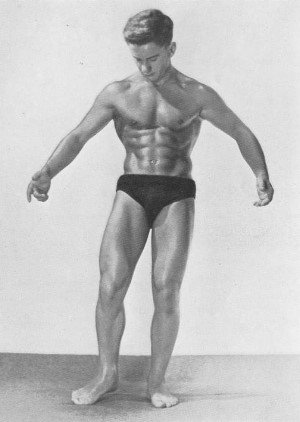
To show interest in body-building at all shows that certain enthusiasm is there. Sometimes, generally when results seem hard to get, enthusiasm sinks to a low ebb, this action in turn tending to encourage the negative emotions of depression and frustration. Practical psychology, if it is to benefit the indifferent body-builder, must show means whereby a good proportion of enthusiasm can be kept up even when major obstacles are encountered, so that the life of the individual may be kept flowing in a more or less positive way.
You’ll notice I said only a proportion of the enthusiasm must be keet up. Why not all of it? It would, of course, be ideal if we could maintain maximum enthusiasm even when faced by great difficulties. I believe that only a few of the more naturally positive-thinking individuals can be at the peak of enthusiasm all the time. It’s my belief that a lack of enthusiasm, at such times when results shown (comparatively speaking) are far below normal, is quite a natural manifestation of the human mind.
Therefore we must realise from the start that enthusiasm will tend to dwindle at times. If we fail to grasp this important fact, we shall only impede our progress still further. Simply by showing concern at our lack of enthusiasm we will encourage still extra depression and therefore even less favourable results will come from our training. So first accept this fact; then concern yourself with the problem of stimulating your feelings, so that this depression period will be as short as possible.
Remember, I said earlier that enthusiasm is generally a natural consequence of increased inspiration. Here, then, lies our answer. In inspirational psychology we find the solution to our problem of inadequate enthusiasm. We’ve all experienced the additional feeling of well-being and increased keenness for training after reading a certain person’s success story or the fine articles written for BODY CULTURE by David Martin and Henry Atkin. After reading such articles we have gone to our barbell and trained, perhaps with more confidence, more happiness and more enthusiasm than for a long time. This, my friends, is because we have been inspired by what we have read.
The very fact that magazines like BODY CULTURE are so consistently enthusiastic in their whole make-up is one reason they are so very desirable. Each month BODY CULTURE, in addition to supplying the best possible technical advice, provides inspiration for thousands of body-builders simply because its instruction, articles, photographs and advice always appear to be so enthusiastic about the whole physical culture game. So when your enthusiasm is below par, turn to inspiration to rekindle that lost spark of keenness.
If you read a success story which particularly impresses you by its triumph over adversity, or even a short news item for that matter, cut it out and put it safely away in a drawer. Do this until you have a little collection, say, 10 or 12, and see they are kept clean, tidy and readable. Keep these stimulating episodes ready for when you arc a little depressed or dissatisfied with your progress. At such times read the inspirational stories over, slowly and deliberately. Continue reading them until your mind is able to completely realise the great difficulties which these successful people had to conquer in their journey to success.
If there is a personal friend whom you particularly admire for his courage and enthusiasm, he may provide you with the inspiration you are seeking. Go to this person and talk to him. Ask advice, and try and adopt a little of his philosophy of life. In these ways you’re certain to benefit. For further inspiration, read the life stories of the world’s famous men and women. You’ll be amazed to find that many of them achieved their greatness in spite of almost impossible odds.
Another good thing is not always to train on your own. I’m sure readers who were in the services during the last war will bear me out when I say that it was only because of the great comradeship which prevailed, and the fact that there was always someone apparently keen, enthusiastic, happy and optimistic, that the miserable, often appalling, war conditions were endured at all.
Certainly, enthusiasm can be very infectious; so if you happen to train alone and suffer from non-enthusiastic spells, try trotting down to the nearest club and chatting with other body-builders. Mix with confident people, people who also share your ideals; the feeling of being ”alone ” is often very real and depressing. Remember, above all, that the majority of your problems in bodybuilding can be helped by adopting a course of positive thought training.
Realise, then, that confidence and enthusiasm are two factors playing a vital part in body-building success—that confidence is increased by having faith in your schedule, and that enthusiasm can nearly always be increased by turning to inspiration.
In a future article I hope to say a little about the other four important points which make for a more positive and successful life. Meanwhile, I’m sure if all body-builders lacking in confidence and enthusiasm will study and apply the principles of positive thought, their perseverance ‘will be well rewarded.
Remember, you are what you are because of what you think. Resolve now to be a success and it will be so.
From Body Culture Volume 1 Number 10, August 1950
Muscle Man FAQ
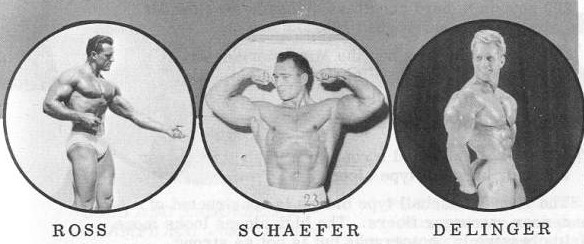
Q: I perform the bent arm pullover with a shoulder width grip and am troubled with binding at the shoulder joint. What causes this and how can I correct it?
A: Use a closer grip. Some bodybuilders are troubled with stiff or inflexible shoulder joints. A wide grip cannot be used in the bent arm pullover. A close grip can. You will obtain just as much benefit either way.
Q: If a bodybuilder poses for an exercise routine which appears in a magazine, does this make him a professional?
A: Not unless the article appears under his name. If he merely serves as the model and the article is written by someone else he remains an amateur.
Q: Which is better for increasing the size of the chest – the pullover or the bench press?
A: Both exercises should be performed for maximum chest size. The bench press develops the muscles of the chest. The pullover increases the size of the chest cage, or rib box. The champions of chest development practice both movements.
Q: Is it possible to obtain maximum leg size and power without the squats ?
A: No! Straddles, the leg press, the ‘hack” exercise and iron boot work DO NOT produce the same degree of power and size squats. However, you do not need to practice the squats every work out. Perform them once or twice a week and on other days you can employ a different leg exercise if you like variety.
Q: Which is constructed stronger: a ‘high 1 biceps, or a round, baseball type biceps?
A: The round, baseball type biceps is constructed of denser, stronger fibers. The high biceps looks more impressive in photographs but is not as strong.
Q: Is there any way that the potential of a beginner can be predetermined?
A: No – and that is one of the most fascinating phases of bodybuilding. The thinnest, most unlikely looking beginner may end up as the celebrated champion while the naturally husky beginner may never make the grade. Success is as much a condition of the mind as physical. Maintain a confident attitude and follow a good course of instructions and you will obtain maximum benefit.
Q: Is it true that Russian athletes use weights for conditioning for ALL sports?
A: According to an article that appeared in Sports Illustrated some time back, even women athletes use weights in Russia. This is undoubtedly one of the big secrets of Russia’s athletic success. More and more American coaches are advocating the use of weights, but still not enough. America will regain world wide athletic supremecy only when ALL athletes train with weights.
Q: Is there an ideal hour for training:—a time when energy is highest?
A: Yes. Research has proved that the average person possesses maximum physical energy in the mid-after-noon. Therefore, if you have a choice, training about 3 PM is ideal. However, the body adjusts its energy level according to physical habit. If you select ANY hour and train regularly at that time, in a few weeks your energy level will be highest then. If you jump around and train at a different hour each work out, you will NEVER build a peak energy level for training. The real key is to select a certain time for training and to STICK to that time.
Charming bodybuilder Richard Du Boix

Muscle man magazine
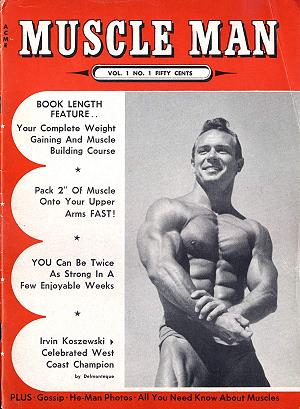
From editorial
Welcome to Muscle Man Magazine.
As you turn the pages, you will discover that Muscle Man is a new type of bodybuilding magazine with a fresh, dynamic approach. It is dedicated to factual, informative and wholesome reporting of every aspect of health, strength, muscle building and constructive living.
It is hoped that Muscle Man will follow in the footsteps of its predecessor, Muscle Sculpture and quickly become one of your favorite publications.
Sincerely, Barton R. Horvath,
Publisher.
Articles on the site:
Why should you train with weights
The Principles of Power Training
Your Complete Weight Gaining Course
Muscle Man Questions and Answers

Body Culture
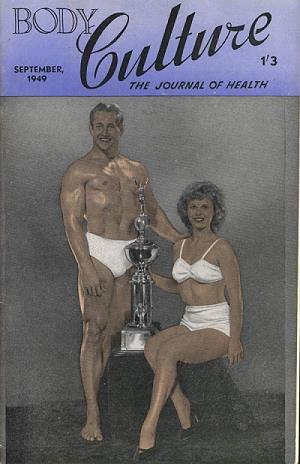
Body Culture magazines
As our name BODY CULTURE implies, this magazine is devoted to the development of the human physique, internally as well as externally. Although not a competitive lifter’s journal, we will publish notes and news regularly regarding weight-lifters and weight-lifting and suggest that would-be and established competition lifters would benefit tremendously through reading, digesting and practising methods of instruction advocated by BODY CULTURE (from editorual of v.1 № 2).
Body Culture volume 1, № 2, September 1949.
Muscular Size And Shape – The Author gives first-rate training instruction invaluable to the bodybuilder experiencing difficulty in developing both large and shapely muscles. The exercises for calves are of special value.
Physical culture in Norway – RUDOLF NESS is Norway’s most prominent advocate of the weight-training way of life, and author of the internationally famous book, “Kruppskultur”.
Body Culture volume 1, № 10, August 1950.
Practical Psychology – how to overcame worries and negative attitude towards life, psychology for bodybuilders.
Body Culture volume 2, № 1, December 1950
The Power of Thought – how to get from motivation to the action, don’t just rest in your imagination about what you are going to do.
Male athlete Robert Smatkowski

Exercises for perpetual daily practice
by Charles Atlas
Dear Friend:

To get the maximum benefits and most satisfactory results from my Course some of the exercises should be carried out faithfully all through life. You have developed the habit of exercising regularly and have noticed its splendid value. But now for Life-Long Health and Strength do the following exercises daily. They are what I believe you need most to keep you fit for LIFE.
EXERCISE N0.1.
For Chest, Shoulders and Back. Excellent for preventing Lung and Chest troubles. Do
For Chest, Shoulders and Back. Excellent for the “dipping” exercise as described in the first Lesson at least 100 times every day. Aim to do it 200 times daily if you are keen on getting a very big and powerful chest development. Do this by dipping 25 or more times, rest and relax a few moments and do them again. Rest and do them again. If you prefer, do 50 to 75 at night. I do 200 or more “dips” daily.
EXERCISE NO. 2.
For the Abdomen. Ideal for preventing or reducing a large stomach, perfecting the digestive system, relieving constipation, preventing rupture and for the general toning up of the body. While lying on the bed clasp the hands back of the head and raise the upper body so that your chin touches your knees, keeping your feet flat on the bed. This is to be done 20 times. Rest awhile and repeat. Rest and relax and do them as many times as you possibly can.
EXERCISE NO. 3.
A similar exercise except that you should bend your knees to touch the upper chest area. This should be done until you are thoroughly tired, then rest, and repeat several times. While doing this exercise open and cross the legs for variation.
EXERCISE NO. 4.
For Thighs, Bow Legs, Knock Knees. Do the squatting exercise spreading apart the knees. Repeat at least 35 times or until tired. Rest awhile and go at them again. Do this exercise energetically. Rest and repeat as before, but this time keep the ankles close together. This will develop the muscles of the back of the thighs. Rest one of you hands on something for support if you find it difficult to balance. These exercises can be performed in the morning as soon as you get up.
EXERCISE No. 5.
Strengthening Internal Organs and Preventing Rupture. Clasp hands behind head while standing erect. Bend far to the right, come up and bend over to the left, keeping the legs straight and bending the upper trunk only. Repeat until you are tired but do not overdo. Rest and relax, then repeat, this time making a complete circular motion.
EXERCISE No. 6.
Developing Biceps, Triceps, Arms and Forearms. Grasp the right wrist with the left hand in front and bring the right hand towards the right shoulder, resisting powerfully with the left hand. Continue till the muscles really begin to ache. Then repeat with the other arm. Rest and do them again.
EXERCISE No. 7.
Strengthening your neck. Bend the neck far downwards, then far backwards. Now side to side, now in a complete circular motion. Rest and relax. Do the same exercises more powerfully by resisting strongly with the hands. These are very effective if done persistently.
EXERCISE No. 8.
Calves, Flat Feet, Fallen Arches and Strengthening weak ankles. Raise up and down on the toes 50 to 100 times. Do this preferable while standing on your toes on the edge of a block about three inches high with your heels overhanging. Another good exercise is to stand on the heels and rock back and forth first on the heels and then on the toes. Do this till really tired. Rest a few minutes and repeat as before.
These exercises can be performed at night, just before getting into bed. Some of them, however, can be done at odd moments during the day. When out walking make a practice of stretching the entire legs and calves to the full limit. Be sure and raise up your toes as you walk along. By keeping this up for a distance equal to about ten blocks you will soon have a fine pair of well-shaped legs. These exercises may seem to you quite a long routine to practice daily for the balance of your life. But thousands upon thousands of men are doing them daily, and very busy men, too, so do not say you haven’t time. You will find when you divide the exercise, doing half in the morning and the other half at night it takes only a few minutes.
In closing, I want to say to you that I have enjoyed sending you these Lessons for I know you must be Stronger, Healthier, more Muscular and full of Pep and Energy. It has been a pleasure to help you. Men and women like you will live longer and enjoy life more.
I hope you will induce your friends to enroll with me, so that I can help them, too. Just send me their names and addresses.
Although this Lesson completes my Course, I want you to feel at liberty to write me at any time if ever you have questions or comments.
With my very best wishes and warm hand clasp, I remain,
Your Sincere Friend and Instructor,
Charles Atlas
